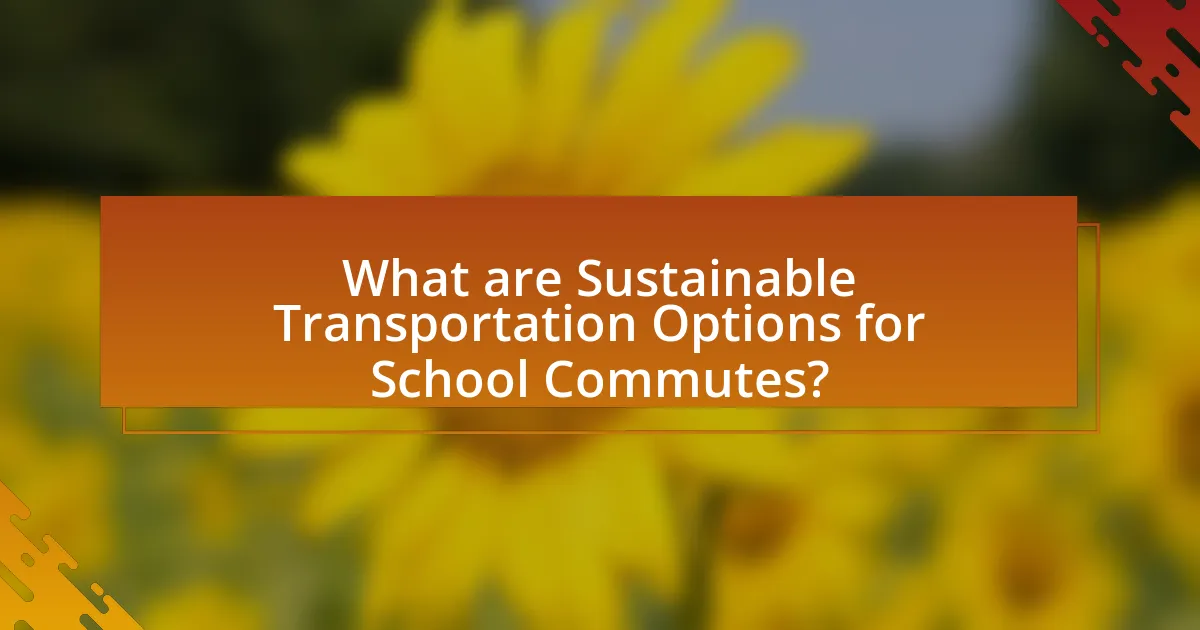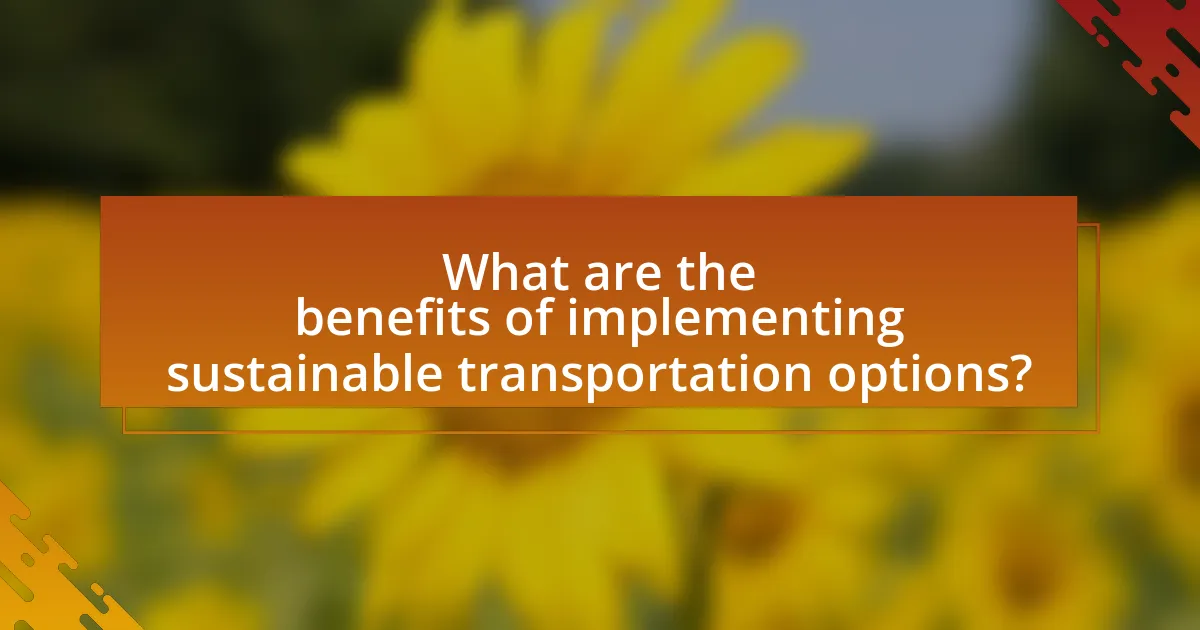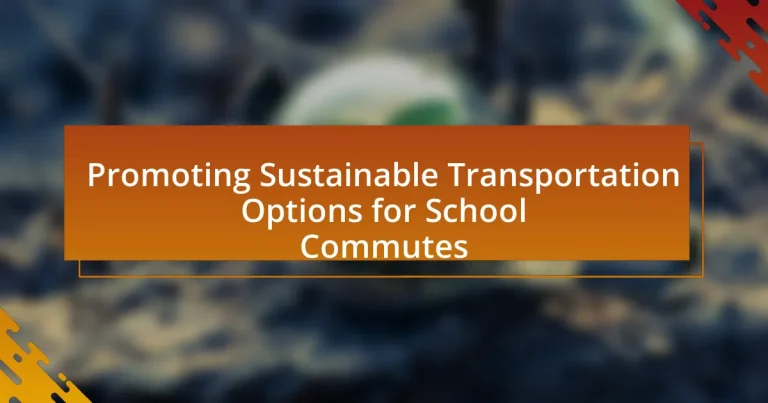The article focuses on promoting sustainable transportation options for school commutes, highlighting methods such as walking, biking, carpooling, and public transit. It discusses the environmental impacts of traditional transportation methods, emphasizing the benefits of sustainable options in reducing carbon footprints and enhancing student health. The article also addresses challenges in implementing these options, including infrastructure limitations and safety concerns, while proposing strategies for schools and communities to encourage sustainable commuting. Additionally, it outlines the economic and health advantages of sustainable transportation, underscoring its role in improving air quality and fostering community engagement.

What are Sustainable Transportation Options for School Commutes?
Sustainable transportation options for school commutes include walking, biking, carpooling, and using public transit. Walking and biking reduce carbon emissions and promote physical health; for instance, studies show that active commuting can decrease childhood obesity rates. Carpooling minimizes the number of vehicles on the road, leading to lower greenhouse gas emissions; data indicates that carpooling can reduce traffic congestion by up to 30%. Public transit, such as buses, is also a sustainable option, as it can transport multiple students simultaneously, significantly reducing per capita emissions. These methods collectively contribute to a more environmentally friendly approach to school transportation.
How do these options differ from traditional transportation methods?
Sustainable transportation options for school commutes differ from traditional methods primarily in their environmental impact and efficiency. Traditional transportation methods, such as single-occupancy vehicles, contribute significantly to greenhouse gas emissions and traffic congestion, whereas sustainable options like walking, biking, or using electric buses reduce carbon footprints and promote healthier lifestyles. For instance, studies show that biking can reduce emissions by up to 50% compared to driving a car for short distances. Additionally, sustainable options often encourage community engagement and physical activity, contrasting with the isolation of traditional car commutes.
What are the environmental impacts of traditional school commutes?
Traditional school commutes primarily contribute to increased greenhouse gas emissions and air pollution due to reliance on fossil fuel-powered vehicles. According to the U.S. Environmental Protection Agency, transportation accounts for approximately 29% of total greenhouse gas emissions, with personal vehicles being a significant contributor. Additionally, traditional commutes often lead to traffic congestion, which exacerbates emissions as vehicles idle and consume fuel inefficiently. Studies indicate that school-related traffic can increase local air pollution levels, negatively impacting children’s health and the environment.
How do sustainable options reduce carbon footprints?
Sustainable options reduce carbon footprints by minimizing greenhouse gas emissions associated with transportation. For instance, using public transit, biking, or walking instead of personal vehicles significantly lowers carbon dioxide emissions; studies show that public transit can reduce per-passenger emissions by up to 45% compared to single-occupancy vehicles. Additionally, electric vehicles, which are increasingly part of sustainable transportation options, produce zero tailpipe emissions, further contributing to a decrease in overall carbon footprints.
Why is promoting sustainable transportation important for schools?
Promoting sustainable transportation is important for schools because it reduces carbon emissions and enhances student health. By encouraging walking, biking, and public transit, schools can significantly lower their environmental impact; for instance, transportation accounts for nearly 29% of greenhouse gas emissions in the United States. Additionally, sustainable transportation options promote physical activity among students, contributing to better overall health and academic performance. Studies show that students who walk or bike to school are more physically active and have improved concentration levels in class.
What health benefits are associated with sustainable commuting?
Sustainable commuting offers several health benefits, including improved cardiovascular health, enhanced mental well-being, and increased physical activity levels. Engaging in sustainable commuting methods, such as walking, cycling, or using public transportation, promotes regular exercise, which is linked to lower risks of heart disease and obesity. Research indicates that individuals who walk or bike to work experience reduced stress levels and improved mood, contributing to better mental health outcomes. Additionally, a study published in the Journal of Transport & Health found that active commuting can lead to a significant increase in daily physical activity, which is essential for maintaining overall health and preventing chronic diseases.
How does sustainable transportation enhance community engagement?
Sustainable transportation enhances community engagement by fostering social interactions and collaboration among residents. When communities adopt sustainable transportation methods, such as biking, walking, or using public transit, they create shared spaces that encourage people to connect and communicate. For instance, studies show that neighborhoods with accessible bike lanes and pedestrian-friendly pathways report higher levels of community participation and social cohesion. This is evidenced by a report from the National Institute for Transportation and Communities, which found that communities with improved walking and biking infrastructure saw a 20% increase in local events and gatherings, demonstrating a direct link between sustainable transportation and enhanced community engagement.
What challenges exist in promoting sustainable transportation for school commutes?
Promoting sustainable transportation for school commutes faces several challenges, including infrastructure limitations, safety concerns, and behavioral resistance. Infrastructure limitations arise from inadequate bike lanes, public transit options, and pedestrian pathways, which hinder the feasibility of sustainable modes of transport. Safety concerns, particularly regarding traffic and the perceived dangers of walking or biking, deter parents and students from choosing these alternatives. Behavioral resistance is evident as many families are accustomed to driving, making it difficult to shift mindsets towards sustainable options. According to a study by the National Center for Safe Routes to School, 70% of children are driven to school, highlighting the entrenched reliance on personal vehicles and the challenges in changing this behavior.
What are the common barriers faced by schools and parents?
Common barriers faced by schools and parents include lack of resources, insufficient infrastructure, and communication gaps. Schools often struggle with limited funding, which affects their ability to implement sustainable transportation programs. Parents may face challenges such as inadequate safe routes for walking or biking, making it difficult for them to choose sustainable options. Additionally, a lack of effective communication between schools and parents can hinder collaboration on transportation initiatives, as evidenced by studies showing that community engagement is crucial for successful implementation of such programs.
How can these challenges be effectively addressed?
To effectively address the challenges of promoting sustainable transportation options for school commutes, implementing comprehensive educational programs and infrastructure improvements is essential. Educational programs can raise awareness about the benefits of sustainable commuting methods, such as walking, biking, and public transit, while infrastructure improvements, like safe bike lanes and pedestrian pathways, facilitate these options. For instance, a study by the National Center for Safe Routes to School found that schools with improved infrastructure saw a 20% increase in students walking or biking to school. This evidence supports the effectiveness of targeted educational initiatives and infrastructure enhancements in overcoming barriers to sustainable transportation.

What strategies can be implemented to promote sustainable transportation?
To promote sustainable transportation, implementing strategies such as enhancing public transit accessibility, encouraging active transportation modes like walking and cycling, and integrating carpooling initiatives is essential. Enhancing public transit accessibility can be achieved by increasing the frequency of services and expanding routes, which has been shown to boost ridership by up to 20% in urban areas. Encouraging active transportation can involve creating safe pedestrian pathways and dedicated bike lanes, leading to a 30% increase in cycling rates in cities that invest in such infrastructure. Additionally, carpooling initiatives can reduce the number of vehicles on the road, with studies indicating that carpooling can decrease traffic congestion by 15% during peak hours. These strategies collectively contribute to reducing greenhouse gas emissions and promoting healthier lifestyles.
How can schools encourage walking and biking to school?
Schools can encourage walking and biking to school by implementing safe routes programs and providing infrastructure such as bike racks and sidewalks. Safe routes programs educate families about safe walking and biking paths, while the installation of bike racks ensures that students have a secure place to store their bicycles. According to the National Center for Safe Routes to School, schools that promote these initiatives see increased rates of students walking and biking, with some reporting a 20% increase in active commuting. Additionally, organizing events like “Walk to School Day” can foster community involvement and raise awareness about the benefits of active transportation.
What infrastructure improvements are necessary for safe walking and biking?
Infrastructure improvements necessary for safe walking and biking include the development of dedicated bike lanes, improved crosswalks, and enhanced lighting. Dedicated bike lanes provide a separate space for cyclists, reducing the risk of accidents with motor vehicles, as evidenced by studies showing that cities with protected bike lanes experience a significant decrease in cyclist injuries. Improved crosswalks, equipped with signals and clear markings, enhance pedestrian visibility and safety, which is critical in school zones where children are present. Additionally, enhanced lighting along pathways and intersections increases safety during low-light conditions, contributing to a safer environment for both pedestrians and cyclists.
How can schools organize walking school buses or bike trains?
Schools can organize walking school buses or bike trains by establishing a structured route, recruiting adult volunteers for supervision, and promoting the initiative to families. A structured route ensures safety and consistency, while adult volunteers provide necessary oversight and guidance. Promoting the initiative can increase participation, as studies show that community involvement enhances the success of such programs. For instance, a report from the National Center for Safe Routes to School indicates that organized walking and biking programs can significantly increase the number of students who commute sustainably, fostering a healthier lifestyle and reducing traffic congestion around schools.
What role do parents and communities play in promoting sustainable options?
Parents and communities play a crucial role in promoting sustainable transportation options for school commutes by actively encouraging and facilitating eco-friendly practices. Parents can model sustainable behaviors, such as walking, biking, or carpooling, which not only reduces carbon emissions but also instills these values in their children. Communities can support this by providing safe infrastructure, such as bike lanes and pedestrian paths, and organizing events that promote awareness of sustainable commuting options. Research indicates that communities with strong parental involvement in sustainability initiatives see a higher adoption rate of these practices, as evidenced by a study from the National Center for Safe Routes to School, which found that schools with engaged parents and community programs reported a 20% increase in walking and biking to school.
How can parent-teacher associations support sustainable transportation initiatives?
Parent-teacher associations can support sustainable transportation initiatives by organizing programs that promote walking, biking, and carpooling among students and families. These associations can facilitate events such as “Walk to School Day” or “Bike to School Week,” which encourage families to choose eco-friendly commuting options. Additionally, they can collaborate with local governments to improve infrastructure, such as safe bike lanes and pedestrian pathways, enhancing accessibility for sustainable transport. Research indicates that schools with active parent-teacher associations see a higher participation rate in sustainable transportation programs, leading to reduced traffic congestion and lower carbon emissions around school zones.
What community partnerships can enhance sustainable commuting efforts?
Community partnerships that can enhance sustainable commuting efforts include collaborations between local governments, schools, and transportation agencies. These partnerships can facilitate the development of safe walking and biking routes, implement carpool programs, and promote public transit options specifically tailored for school commutes. For instance, a study by the National Center for Safe Routes to School found that communities with active partnerships saw a 20% increase in students walking or biking to school. Additionally, partnerships with local businesses can provide incentives for families to choose sustainable commuting methods, further promoting a culture of sustainability within the community.
What educational programs can raise awareness about sustainable transportation?
Educational programs that can raise awareness about sustainable transportation include school-based initiatives like the “Safe Routes to School” program, which promotes walking and biking to school, and the “Green Schools” program, which integrates sustainability into the curriculum. These programs have been shown to increase student participation in sustainable commuting options, as evidenced by a study from the National Center for Safe Routes to School, which reported a 20% increase in walking and biking among participating schools. Additionally, community workshops and educational campaigns focused on the environmental impacts of transportation can further enhance awareness and encourage behavioral changes towards more sustainable commuting practices.
How can schools integrate sustainability into their curriculum?
Schools can integrate sustainability into their curriculum by incorporating environmental education across various subjects and promoting hands-on projects related to sustainable practices. For instance, science classes can include lessons on ecosystems and renewable energy, while social studies can explore the impact of transportation on climate change. Research indicates that experiential learning, such as school gardens or recycling programs, enhances student engagement and understanding of sustainability concepts. A study by the National Environmental Education Foundation found that students involved in environmental education show improved academic performance and a greater commitment to sustainable practices.
What resources are available for teaching students about sustainable commuting?
Resources available for teaching students about sustainable commuting include educational programs, online platforms, and community initiatives. Programs like the “Safe Routes to School” initiative provide materials and resources to encourage walking and biking. Online platforms such as the National Center for Safe Routes to School offer lesson plans and activities focused on sustainable transportation. Additionally, community initiatives often involve local governments and organizations that promote carpooling and public transit use through workshops and informational sessions. These resources collectively aim to educate students on the benefits of sustainable commuting, including reduced carbon emissions and improved health outcomes.

What are the benefits of implementing sustainable transportation options?
Implementing sustainable transportation options significantly reduces greenhouse gas emissions, contributing to improved air quality and public health. For instance, a study by the American Public Transportation Association found that public transit use in the U.S. saves approximately 45 million metric tons of carbon dioxide annually. Additionally, sustainable transportation promotes energy efficiency, as electric and hybrid vehicles consume less energy compared to traditional gasoline-powered cars. Furthermore, these options can enhance community connectivity and accessibility, making it easier for students to commute to school safely and efficiently.
How do sustainable transportation options impact student health and well-being?
Sustainable transportation options positively impact student health and well-being by promoting physical activity and reducing exposure to air pollution. When students engage in walking, cycling, or using public transit, they increase their daily exercise levels, which is linked to improved cardiovascular health and mental well-being. A study published in the Journal of Transport & Health found that students who walked or cycled to school had lower body mass index (BMI) and reported higher levels of happiness compared to those who were driven. Additionally, sustainable transportation reduces vehicular emissions, leading to better air quality, which is crucial for respiratory health. Research from the World Health Organization indicates that improved air quality can significantly decrease the incidence of asthma and other respiratory issues among children.
What are the physical health benefits of walking and biking to school?
Walking and biking to school significantly improve physical health by enhancing cardiovascular fitness, increasing muscle strength, and promoting healthy weight management. Engaging in these activities regularly can lead to lower risks of obesity, heart disease, and diabetes. Research indicates that children who walk or bike to school are more likely to meet daily physical activity recommendations, which is essential for overall health. For instance, a study published in the Journal of Physical Activity and Health found that active commuting contributes to higher levels of physical activity among children, thereby supporting their physical development and well-being.
How does sustainable commuting contribute to mental health improvements?
Sustainable commuting contributes to mental health improvements by reducing stress and enhancing overall well-being. Engaging in sustainable transportation methods, such as walking, cycling, or using public transit, promotes physical activity, which is linked to lower levels of anxiety and depression. A study published in the Journal of Transport & Health found that individuals who commute sustainably report higher life satisfaction and lower stress levels compared to those who rely on cars. Additionally, sustainable commuting fosters social interactions and community engagement, further supporting mental health through social connectedness.
What economic advantages do sustainable transportation options offer?
Sustainable transportation options offer significant economic advantages, including reduced operational costs and increased efficiency. For instance, electric buses and bicycles have lower fuel and maintenance costs compared to traditional gasoline-powered vehicles, leading to savings for schools and municipalities. A study by the American Public Transportation Association found that every $1 invested in public transportation generates approximately $4 in economic returns, highlighting the broader economic impact of sustainable transport initiatives. Additionally, sustainable transportation can reduce traffic congestion, which in turn lowers costs associated with lost productivity and vehicle wear and tear.
How can schools save money through sustainable transportation initiatives?
Schools can save money through sustainable transportation initiatives by reducing transportation costs and increasing funding opportunities. Implementing programs such as walking school buses, bike-to-school days, and carpooling can lower fuel expenses and maintenance costs associated with school buses. For instance, a study by the National Center for Safe Routes to School found that schools that promoted walking and biking saw a decrease in transportation costs by up to 20%. Additionally, schools can access grants and funding specifically aimed at promoting sustainable transportation, which can further offset costs. By investing in infrastructure for biking and walking, schools not only save money but also enhance student health and community engagement.
What are the long-term financial benefits for families and communities?
Long-term financial benefits for families and communities include reduced transportation costs, increased property values, and enhanced local economies. Families save money on fuel, maintenance, and parking by utilizing sustainable transportation options such as walking, biking, or public transit. A study by the Victoria Transport Policy Institute indicates that households can save an average of $9,000 annually by reducing car dependency. Communities benefit from increased property values as neighborhoods with accessible transportation options attract more residents. Additionally, local economies thrive as sustainable transportation encourages spending at nearby businesses, fostering job creation and economic growth.
What environmental benefits arise from promoting sustainable transportation?
Promoting sustainable transportation leads to significant environmental benefits, including reduced greenhouse gas emissions and improved air quality. For instance, transitioning from fossil fuel-based vehicles to electric or non-motorized options can decrease carbon dioxide emissions by up to 50% per mile traveled. Additionally, sustainable transportation methods, such as biking and walking, contribute to lower levels of air pollutants, which can reduce respiratory illnesses and enhance public health. Studies indicate that cities implementing extensive public transit systems can see a reduction in vehicle miles traveled, further decreasing urban congestion and its associated environmental impacts.
How do these options contribute to reducing air pollution?
Sustainable transportation options for school commutes, such as walking, biking, carpooling, and using public transit, significantly reduce air pollution by decreasing the number of individual vehicles on the road. For instance, studies show that carpooling can reduce greenhouse gas emissions by up to 45% per vehicle, while biking and walking produce zero emissions. Additionally, public transit systems can carry multiple passengers simultaneously, leading to fewer cars on the road and a reduction in overall emissions. These options not only lower the volume of traffic but also promote cleaner air quality in urban areas, contributing to a healthier environment for students and communities.
What role do sustainable transportation options play in combating climate change?
Sustainable transportation options significantly reduce greenhouse gas emissions, which are a primary driver of climate change. By utilizing modes such as cycling, walking, public transit, and electric vehicles, communities can decrease reliance on fossil fuels. For instance, a study by the International Council on Clean Transportation found that electric vehicles can reduce emissions by up to 70% compared to conventional gasoline vehicles. Additionally, promoting public transit can lead to a reduction of approximately 45 million metric tons of CO2 annually in the United States alone, as reported by the American Public Transportation Association. Therefore, sustainable transportation options play a crucial role in mitigating climate change by lowering emissions and promoting energy efficiency.
What practical steps can schools take to implement sustainable transportation options?
Schools can implement sustainable transportation options by establishing safe walking and biking routes, promoting carpooling programs, and integrating public transportation into their transportation plans. Creating designated paths for pedestrians and cyclists encourages students to walk or bike, reducing reliance on cars. Carpooling initiatives can be facilitated through apps or school-organized events, which help decrease the number of vehicles during drop-off and pick-up times. Additionally, collaborating with local transit authorities to provide discounted or free public transport passes for students can further promote the use of eco-friendly transportation methods. These steps not only reduce carbon emissions but also foster a healthier lifestyle among students.
What are the best practices for launching a sustainable transportation program?
The best practices for launching a sustainable transportation program include conducting a thorough needs assessment, engaging stakeholders, and implementing a pilot program. Conducting a needs assessment helps identify the specific transportation challenges and opportunities within the community, ensuring that the program addresses real issues. Engaging stakeholders, such as parents, school officials, and local government, fosters collaboration and support, which is crucial for program success. Implementing a pilot program allows for testing and refining strategies based on feedback and observed outcomes, leading to more effective long-term solutions. Research indicates that programs involving community input and iterative testing are more likely to achieve sustainability and user adoption.
How can schools measure the success of their sustainable transportation initiatives?
Schools can measure the success of their sustainable transportation initiatives by tracking key performance indicators such as the percentage increase in students using eco-friendly transportation modes, including walking, biking, and public transit. For instance, a study conducted by the National Center for Safe Routes to School found that schools implementing sustainable transportation programs saw a 20% increase in students walking or biking to school over a three-year period. Additionally, schools can assess reductions in carbon emissions by calculating the decrease in vehicle trips associated with school commutes, which can be quantified using local traffic data and emissions factors. Surveys and feedback from students and parents can also provide qualitative insights into the perceived effectiveness and acceptance of these initiatives.


